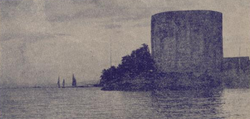Top Qs
Timeline
Chat
Perspective
Spanish colonial fortifications in the Philippines
From Wikipedia, the free encyclopedia
Remove ads
The Spanish fortifications of the Philippines, or fuerzas, are strongholds constructed by Filipinos and Spaniards primarily for protection against local and foreign aggressors during the Spanish colonial period, and during the subsequent American and Japanese occupations. Structures built included fortresses, watchtowers, and bastions. Many are badly damaged, either due to old age or past conflicts. Currently, there are initiatives for restorations of all forts, beginning when the Baluarte Luna of La Union and the Intramuros of Manila were restored in the 2010s. In 2013, a typhoon and earthquake hit Central Visayas and damaged numerous Spanish fortifications, leading to the largest restoration activity for fortifications in Philippine history.

Remove ads
List of forts
Remove ads
UNESCO World Heritage status
Summarize
Perspective
Tentative list
On May 16, 2006, a collection of five well-preserved examples of Spanish Colonial architecture was added to the UNESCO World Heritage Tentative List in the Cultural category.[2]
The collection titled "Spanish Colonial Fortifications of the Philippines" include the following buildings located throughout the country:
- Fuerza de Capul, Northern Samar
- Dauis Watchtower, Dauis, Bohol
- Punta Cruz Watchtower, Maribojoc, Bohol
- Fuerza de San Andres, Romblon, Romblon
- Fuerza de Sta. Isabel, Taytay, Palawan
In 2015, by recommendation of UNESCO, the fortifications were removed from the tentative list of the Philippines as they 'will have a hard time meeting the standards of the organization'. The old town of Capul (Northern Samar), old town of Romblon (Romblon province), and old town of Taytay (Palawan) were recommended as possible heritage sites in the future once the Philippines submits them in the tentative list, along with a complete dossier.
Future reinclusion list
Heritage groups have been advocating for the return of the fortifications in the tentative list, but with the inclusion of at least twenty-one more Spanish colonial fortifications throughout the country to maximize its potential to be included in the World Heritage List. Restoration activities on numerous fortifications throughout the country are currently ongoing in a bid to support the future nomination of the fortifications to UNESCO. However, some fortifications are within private lands, hindering cultural agencies of government from restoring those forts. The possible return of the fortifications in the tentative list is supported by both governments of the Philippines and Spain. Other proposed properties are:
- Intramuros, Manila
- Cuartel de Santo Domingo, Santa Rosa, Laguna
- Fuerza de Cuyo, Cuyo, Palawan
- Fuerza de Cagayancillo, Cagayancillo, Palawan
- Real Fuerza de Nuestra Señora del Pilar de Zaragoza, Zamboanga City
- Fuerza de San Felipe, Cavite City
- Fuerza de San Pedro, Cebu
- Fuerte de la Concepcion y del Triunfo, Ozamiz, Misamis Occidental
- Fuerza de San Antonio Abad, Manila
- Fuerza de Pikit, Malidegao, Cotabato
- Fuerza de Santiago, Romblon, Romblon
- Fuerza de Jolo, Jolo, Sulu
- Fuerza de Masbate, Masbate
- Fuerza de Bongabong, Bongabong, Oriental Mindoro
- Cotta de Dapitan, Dapitan, Zamboanga del Norte
- Fuerte de Alfonso XII, Tukuran, Zamboanga del Sur
- Fuerza de Bacolod, Bacolod, Lanao del Norte
- Guinsiliban Watchtower, Guinsiliban, Camiguin
- Laguindingan Watchtower, Laguindingan, Misamis Oriental
- Kutang San Diego, Gumaca, Quezon
- Baluarte Luna, Luna, La Union
Remove ads
See also
Architecture of the Philippines
References
Further reading
External links
Wikiwand - on
Seamless Wikipedia browsing. On steroids.
Remove ads



































































